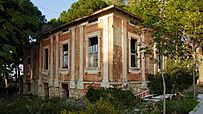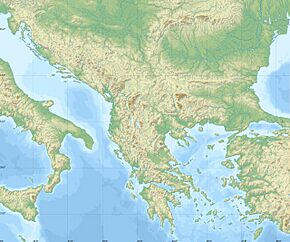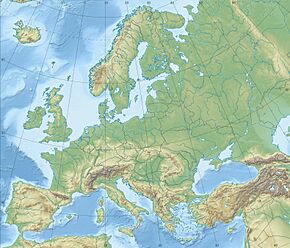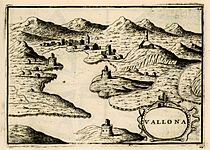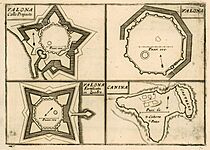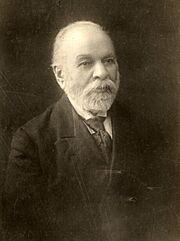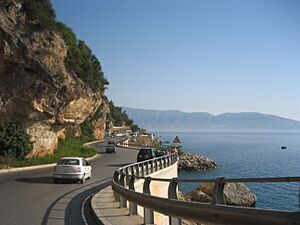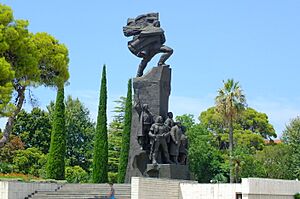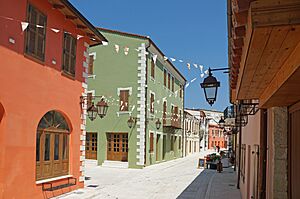Vlorë facts for kids
Quick facts for kids
Vlorë
|
|||
|---|---|---|---|
|
Municipality and city
|
|||
|
From top to bottom, left to right: Promenade of Vlorë, Muradie Mosque, Old house on the Dhimiter Konomi Street, Old Town of Vlorë, Independence Monument and Lungomare.
|
|||
|
|||
| Country | |||
| Region | Southern Albania | ||
| County | Vlorë | ||
| Founded | 6th c. BCE (Triport site) | ||
| Government | |||
| • Type | Mayor–council | ||
| • Body | Vlorë Municipal Council | ||
| Area | |||
| • Municipality | 616.85 km2 (238.17 sq mi) | ||
| • Administrative unit | 28.97 km2 (11.19 sq mi) | ||
| Elevation | 0 m (0 ft) | ||
| Population
(2011)
|
|||
| • Municipality | 130,827 | ||
| • Municipality density | 169.9/km2 (440/sq mi) | ||
| • Administrative unit | 79,513 | ||
| Demonym(s) | Albanian: Vlonjat (m), Vlonjate (f) | ||
| Time zone | UTC+1 (CET) | ||
| • Summer (DST) | UTC+2 (CEST) | ||
| Postal code |
9400
|
||
| Area code(s) | +355 (0) 33 | ||
| Seaport | Port of Vlorë | ||
| Motorways | |||
| Highways | |||
| Vehicle registration | VL | ||
Vlorë is a major city in southwestern Albania. It is the third largest city in the country. Vlorë is located on the Bay of Vlorë, surrounded by the Ceraunian Mountains. It sits along both the Adriatic and Ionian Sea Coasts. The city has a Mediterranean climate, meaning it has hot, dry summers and mild, wet winters.
Vlorë is a very old city. People lived in this coastal area as early as 11th-10th centuries BCE. Ancient Greeks later settled here. A large, walled port city existed nearby from the 6th century BCE to the 2nd century AD. This ancient city was called Aulon, which is where the modern name Vlorë comes from. Throughout history, Vlorë was ruled by many different empires, including the Romans, Byzantines, Normans, Venetians, and Ottomans.
Vlorë played a key role in Albania's history. In 1912, the Declaration of Independence was signed here, making Vlorë the first capital of modern Albania. Today, Vlorë is an important city in southern Albania. It is known for its culture and traditions. The city has a busy port and is connected by major highways.
Contents
What's in a Name?
The name Vlorë comes from the ancient Greek word Aulṓn, which means "channel" or "glen." This name was first written down in the 2nd century AD by Greek writers. They described it as a "town and sea-port," showing it was an important place long ago.
Over time, the name Aulon changed into Vlorë as the Albanian language developed. In some parts of Albania, especially in the north, people still say Vlonë. The way the name is pronounced and how the people of Vlorë are called (like vlonjat) also follow old Albanian language rules.
Throughout history, Vlorë has had different names in other languages. In Greek, it's Avlónas. The Latin name was Aulona, and the Italian name was Valona. During the time of the Ottoman Empire, it was known as Avlonya in Turkish.
Vlorë Through Time
Historical affiliations
Illyrians (Taulantii),
Ancient Greeks
Roman Empire, 226 BCE–286
Byzantine Empire, 286-c. 705
South Slavs, c. 705–784
Byzantine Empire, 784–1204
Despotate of Epirus, 1204-1346
Principality of Valona, 1346–1417
![]() League of Lezhë 1443-1478
League of Lezhë 1443-1478
![]() Ottoman Empire, 1417–1691
Ottoman Empire, 1417–1691
![]() Republic of Venice, 1691–1698
Republic of Venice, 1691–1698
![]() Ottoman Empire, 1698–1912
Ottoman Empire, 1698–1912
![]() Independent Albania, 1912–1914
Independent Albania, 1912–1914
![]() Principality of Albania, 1915–1917
Principality of Albania, 1915–1917
![]() Italian protectorate over Albania, 1917–1920
Italian protectorate over Albania, 1917–1920
![]() Principality of Albania, 1920–1925
Principality of Albania, 1920–1925
![]() Albanian Republic, 1925–1928
Albanian Republic, 1925–1928
![]() Albanian Kingdom, 1928–1939
Albanian Kingdom, 1928–1939
![]() Kingdom of Albania, 1939–1943
Kingdom of Albania, 1939–1943
![]() Albanian Kingdom, 1943–1944
Albanian Kingdom, 1943–1944
![]() Democratic Government of Albania, 1944–1946
Democratic Government of Albania, 1944–1946
![]() People's Socialist Republic of Albania, 1946–1992
People's Socialist Republic of Albania, 1946–1992
![]() Albania, 1992–present
Albania, 1992–present
Early Beginnings

Island
•
Vlorë
Mountains
Bay of Vlorë and Ceraunian Mts.
The coastal area around Vlorë has been active since ancient times. People lived here as early as 1100-1000 BCE. Later, in the 8th century BC, Ancient Greeks started to settle in the area. They founded important towns like Orikos, Thronion, and Aulon.
Vlorë's location on the Adriatic Sea and its natural harbor made it a very important place for trade. A large, fortified port city called Triport existed northwest of modern Vlorë. It was used from the 6th century BCE until the Middle Ages. Over time, the main city likely moved from Triport to where Vlorë is today. The modern city still has ancient walls from the 4th to 10th centuries CE.
The ancient city of Aulon, which gave Vlorë its name, was first mentioned in the 2nd century CE. It was an important port for the Roman Empire.
Middle Ages and Ottoman Rule
In the 11th and 12th centuries, Vlorë was a key location in battles between the Byzantine Empire and the Normans. The city was the capital of the Principality of Valona from 1346 to 1417. This was an independent Christian state for some time.
The Ottoman Empire took control of Vlorë in 1417. However, Albanian rebels briefly freed the city in 1432. Vlorë became an important trading port under Ottoman rule, connecting western Europe with the Ottoman lands.
In 1426, the Ottomans allowed a Jewish community to settle in Vlorë. Many Jews came from other parts of Europe, especially after they were expelled from Spain in 1492. This community grew and played a big role in trade. They imported goods from Europe and exported items like spices and fabrics from Ottoman cities.
Albanian Independence
Between the 18th and 19th centuries, Albanians worked to strengthen their national identity. This led to the Albanian Renaissance, a period of cultural and political awakening. Vlorë became a central place for this movement. In 1833, Albanian rebels took control of Vlorë, forcing the Ottoman government to make changes.
On November 28, 1912, a very important event happened in Vlorë. Ismail Qemali led the signing of the Albanian Declaration of Independence during the First Balkan War. This made Vlorë the first capital of independent Albania.
During World War I, Italy invaded and occupied Vlorë in 1914. Albanian rebels fought back and forced the Italians out in 1920. Italy invaded Vlorë again in 1939, and later Nazi Germany occupied the city during World War II. Vlorë was finally freed in 1944 by Albanian forces.
Modern History
After World War II, Albania became a communist country. The port of Vlorë was used by the Soviet Union as a submarine base for a while. In the 1960s, Albania's leader, Enver Hoxha, had disagreements with the Soviet Union. This led to the Soviets leaving Vlorë. Hoxha then ordered the building of many concrete bunkers across Albania to protect the country.
In 1997, Vlorë was at the center of a period of unrest in Albania. This happened after many people lost their savings in failed investment schemes.
Vlorë's Location and Nature
Vlorë is located on the Bay of Vlorë, where the Adriatic Sea meets the Ionian Sea. The city is surrounded by the foothills of the Ceraunian Mountains. The Vlorë Municipality covers about 648 square kilometers. It includes the Karaburun Peninsula and Sazan Island to the west.
The area has several important natural protected areas. These include the Karaburun-Sazan Marine Park, which protects marine life, and Llogara National Park, known for its beautiful landscapes. The Vjosa Wild River National Park is also nearby. The name for a type of oak tree, Valonia oak, comes from Vlorë's old name, Valona. These trees were important for their acorns, which were used by leather tanners.
Vlorë's Climate
Vlorë has a Mediterranean climate. This means it has hot and dry summers, and mild, rainy winters. The average temperature for the year is about 16.9 degrees Celsius. August is the warmest month, with temperatures around 26.8 degrees Celsius. January is the coldest, with temperatures around 7.9 degrees Celsius.
Vlorë is a very sunny city, getting about 2,745 hours of sunshine each year. July is the sunniest month, with about 12 hours of sunshine per day. While it gets a lot of sun, Vlorë also has rainy days, especially in winter. Snowfall is very rare, usually only happening about one day a year.
| Climate data for Vlorë | |||||||||||||
|---|---|---|---|---|---|---|---|---|---|---|---|---|---|
| Month | Jan | Feb | Mar | Apr | May | Jun | Jul | Aug | Sep | Oct | Nov | Dec | Year |
| Mean daily maximum °C (°F) | 13.2 (55.8) |
13.9 (57.0) |
15.9 (60.6) |
19.0 (66.2) |
23.2 (73.8) |
27.0 (80.6) |
29.7 (85.5) |
29.8 (85.6) |
27.0 (80.6) |
22.8 (73.0) |
18.2 (64.8) |
14.5 (58.1) |
21.2 (70.1) |
| Daily mean °C (°F) | 10 (50) |
10 (50) |
12 (54) |
15 (59) |
19 (66) |
22 (72) |
25 (77) |
25 (77) |
22 (72) |
19 (66) |
15 (59) |
12 (54) |
17 (63) |
| Mean daily minimum °C (°F) | 4.8 (40.6) |
5.3 (41.5) |
6.6 (43.9) |
9.6 (49.3) |
13.2 (55.8) |
16.6 (61.9) |
18.4 (65.1) |
18.3 (64.9) |
15.9 (60.6) |
12.5 (54.5) |
9.5 (49.1) |
6.3 (43.3) |
11.4 (52.5) |
| Average precipitation mm (inches) | 113.5 (4.47) |
86.3 (3.40) |
90.4 (3.56) |
65.3 (2.57) |
56.8 (2.24) |
19.1 (0.75) |
12.4 (0.49) |
21.1 (0.83) |
69.2 (2.72) |
124.1 (4.89) |
138.4 (5.45) |
145.0 (5.71) |
941.6 (37.08) |
| Average precipitation days | 13 | 12 | 14 | 11 | 9 | 6 | 3 | 3 | 5 | 10 | 17 | 17 | 120 |
| Mean monthly sunshine hours | 133.3 | 147.9 | 173.6 | 225.0 | 272.8 | 318.0 | 368.9 | 344.1 | 279.0 | 210.8 | 117.0 | 99.2 | 2,689.6 |
| Mean daily sunshine hours | 4 | 5 | 5 | 7 | 8 | 10 | 11 | 11 | 9 | 6 | 3 | 3 | 7 |
| Mean daily daylight hours | 9 | 10 | 11 | 13 | 14 | 15 | 14 | 13 | 12 | 11 | 9 | 9 | 12 |
| Source: NOAA | |||||||||||||
Vlorë's Economy
Vlorë is a very important port city and a center for business. It has a strong fishing industry and other factories. The area around Vlorë produces petroleum, natural gas, and salt. The city is also home to important parts of the Albanian Navy.
Vlorë is growing as an agricultural center, with many olive and fruit trees. It also has industries that process food, oil, and bitumen. Historically, the region produced oats, corn, cotton, and raised cattle and sheep. These goods are still exported today.
Vlorë has modern buildings and many places to live. The city is divided into three economic zones. The Free Economic Zone TEDA Vlorë is a special area for businesses. It is good for industrial activities, processing, storage, and making things like electronics and car parts.
In 2016, the World Bank said Vlorë had made big improvements in its economy. It ranked 7th among 22 cities in Southeastern Europe. This was even better than Albania's capital, Tirana, and other major cities like Belgrade and Sarajevo.
Tourism is a huge part of Vlorë's economy. Many hotels and resorts have been built, and the city has beautiful beaches. Vlorë offers great views of the Bay of Vlorë. Sazan Island is right in front of the city's bay. Popular beaches nearby include Palasë, Dhermi, and Himara. In 2019, the Financial Times listed Vlorë as one of the "Five destinations to watch" for new and exciting holidays.
Recently, in April 2024, it was announced that Jared Kushner plans to build a resort in Vlorë. This is part of his company's plans to invest in the Balkans.
Getting Around Vlorë
Vlorë is a key point in Albania's north-south transportation system. It has a network of highways that connect it to other parts of the country. The SH8 highway links Vlorë's northern areas with its central and southern parts. It then continues along the beautiful Albanian Riviera to Sarandë. The A2 motorway also runs from Fier to Vlorë. A new bypass is being built to connect the A2 motorway directly to the SH8 highway.
The city is served by the Port of Vlorë, which is the second busiest port in Albania. It is located on the northern part of the city's coast.
Vlorë also has a train station, which is the end point of the Durrës-Vlorë railway line. This line connects Vlorë to Durrës and the rest of Albania's train network. While passenger trains stopped running south of Fier in 2015, a private company, Albrail, started running freight trains from Fier to Vlorë in 2018.
A new airport, the Vlorë International Airport, is currently being built. It is planned to increase travel to southern Albania. The airport is located near the village of Akërni. Construction started in November 2021 and is expected to finish by April 2024. The airport plans also include a marina and a place for agritourism.
Waste Management
From 2020 to 2024, Vlorë faced problems with fires at its local landfill. This landfill is considered dangerous. A new landfill was supposed to open by June 2021, but its opening has been delayed many times.
Learning in Vlorë
Vlorë is home to the second largest university in Albania, the University of Vlora. It was founded in 1994 as a technology university. While it still focuses on technology, it has also grown to include studies in economics, finance, education, medicine, and law.
The University of Vlora publishes three journals. One is a scientific journal in Albanian called Buletini Shkencor i Universitetit te Vlorës. Since 2008, it has also been home to the Academicus International Scientific Journal, which is a scientific publication in English.
Besides the state university, there are two private universities in Vlorë: Universiteti Pavarësia Vlorë and Akademia e Studimeve të Aplikuara "Reald".
People of Vlorë
| Population history of Vlorë in selected periods | ||||||
|---|---|---|---|---|---|---|
| Year | 1923 | 1927 | 1938 | 1989 | 2001 | 2011 |
| Pop. | 5,942 | 6,210 | 9,948 | 71,662 | 77,652 | 79,513 |
| ±% p.a. | — | +1.11% | +4.38% | +3.95% | +0.67% | +0.24% |
According to the 2011 census, about 79,513 people lived in the city of Vlorë. The wider Vlorë Municipality had about 104,827 people. This makes Vlorë the third most populated city and fifth most populated municipality in Albania. The population density of Vlorë Municipality is about 169.9 people per square kilometer. The city's population grew from 71,662 in 1989 to 79,513 in 2011.
Albania is a secular country, meaning it has no official religion. It protects the freedom of religion and belief. Vlorë has a diverse mix of religions. People here traditionally follow Islam, Christianity, and Judaism. In the 19th and early 20th centuries, most people in Vlorë were Albanian-speaking Muslims. There were also smaller groups of Greek-speaking families, Albanian Orthodox Christians, Jews, and Catholics.
Vlorë's Culture
Vlorë is part of the historical region of Labëria, which stretches along Albania's coasts and into its mountains. Labëria is famous for its unique culture, traditions, and folklore. It is known as the birthplace of Albanian polyphonic music, a special type of singing recognized by UNESCO as a "Masterpiece of the Oral and Intangible Heritage of Humanity." Most Albanian people in Vlorë speak the Lab dialect of southern Tosk Albanian.
Vlorë has many cultural and historical sites, especially those related to Albania's founding. The Monument of Independence is in Flag's Square. It celebrates Albania becoming independent from the Ottoman Empire. The Museum of Independence is in a 19th-century building where Albania's founding fathers signed the Declaration of Independence. Its balcony is a symbol of freedom for Albanians.
The Ethnographic Museum, located in another 19th-century mansion, shows the traditional heritage of Vlorë. The History Museum on Perlat Rexhepi Street displays artifacts from ancient Illyrians and Ancient Greeks. There are also plans to open a museum dedicated to Vlorë's historical Jewish population.
Important religious sites in Vlorë include the Muradie Mosque, built in the 16th century, and the Saint Aloysius Gonzaga and Mary Church from the 19th century. Other interesting cultural places in the Vlorë area are the Castle of Kaninë, the Church of Marmiroi, Sazan Island, Island of Zvërnec, and the Lagoon of Narta. Ancient archaeological sites like Amantia and Oricum are also nearby.
Vlorë's main football team is KS Flamurtari Vlorë. They play at Flamurtari Stadium, which is in the city center near Independence Square.
Vlorë's International Friends
Vlorë is connected with other cities around the world. These are called "sister cities":
 Hollywood, Florida, United States
Hollywood, Florida, United States Yangzhou, China
Yangzhou, China
Gallery
See also
 In Spanish: Vlorë para niños
In Spanish: Vlorë para niños




